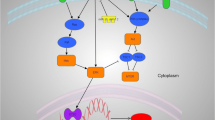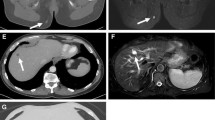Abstract
Chordoma is a rare low-grade primary malignant skeletal tumor, which is presumed to derive from notochord remnants. The pathogenesis of chordoma has not been fully elucidated. However, recent advances in the molecular biology studies have identified brachyury underlying the initiation and progression of chordoma cells. More efforts have been made on accumulating evidence of the notochordal origin of chordoma, discovering signaling pathways and identifying crucial targets in chordomagenesis. In this review, we summarize the most recent research findings and focus on the pathophysiology and molecular mechanisms of chordoma.

Similar content being viewed by others
References
Papers of particular interest, published recently, have been highlighted as: • Of importance
Walcott BP, Nahed BV, Mohyeldin A, et al. Chordoma: current concepts, management, and future directions. Lancet Oncol. 2012;13(2):e69–76.
Bjornsson J, Wold LE, Ebersold MJ, et al. Chordoma of the mobile spine. A clinicopathologic analysis of 40 patients. Cancer. 1993;71(3):735–40.
Yakkioui Y, van Overbeeke JJ, Santegoeds R, et al. Chordoma: the entity. Biochim Biophys Acta. 2014;1846(2):655–69.
Ferraresi V, Nuzzo C, Zoccali C, et al. Chordoma: clinical characteristics, management and prognosis of a case series of 25 patients. BMC Cancer. 2010;10:22.
Casali PG, Stacchiotti S, Sangalli C, et al. Chordoma. Curr Opin Oncol. 2007;19(4):367–70.
Wiacek MP, Kaczmarek K, Sulewski A, et al. Unusual location of chordoma metastasis. Pol Orthop Traumatol. 2014;79:47–9.
Lee SH, Ahn BK. Sacral chordoma: challenging for resection margin. Ann Coloproctol. 2014;30(3):104–5.
M¨uller H, Ueber das Vorkommen von Resten der Chorda dorsalisbeiMenschennachderGeburtund ¨uber ihrVerh¨altniss zu den Gallertgeschw¨ulsten am Clivus. Zeitung F¨ur Rationelle Medizin. 1858; 2: 202.
Ribbert H, Uber die Ecchondrosis Physalifora Sphenooccipitalis. Zentralblatt F¨ur Allgemeine Pathologie Und Pathologische Anatomie. 1894; 5: 457–61.
Chauvel A, Taillat F, Gille O, et al. Giant vertebral notochordal rest: a new entity distinct from chordoma. Histopathology. 2005;47(6):646–9.
Choi KS, Cohn MJ, Harfe BD. Identification of nucleus pulposus precursor cells and notochordal remnants in the mouse: implications for disk degeneration and chordoma formation. Dev Dyn. 2008;237(12):3953–8.
Yamaguchi T, Suzuki S, Ishiiwa H, et al. Benign notochordal cell tumors: a comparative histological study of benign notochordal cell tumors, classic chordomas, and notochordal vestiges of fetal intervertebral discs. Am J Surg Pathol. 2004;28(6):756–61.
Kreshak J, Larousserie F, Picci P, et al. Difficulty distinguishing benign notochordal cell tumor from chordoma further suggests a link between them. Cancer Imaging. 2014;14:4.
Aydemir E, Bayrak OF, Sahin F, et al. Characterization of cancer stem-like cells in chordoma. J Neurosurg. 2012;116(4):810–20.
Hsu ea W. Identification of cancer stem cells in human chordoma, 27th annual meeting of th AANS/CNS section on disorders of the spine and peripheral nerves. J Neurosurg. 2011;30(3):A1–25.
Feng Y, Shen JK, Hornicek FJ, et al. Genomic and epigenetic instability in chordoma: current insights. Clin Cosmet Investig Dent. 2014;6:45–56.
Le LP, Nielsen GP, Rosenberg AE, et al. Recurrent chromosomal copy number alterations in sporadic chordomas. PLoS One. 2011;6(5):e18846.
Scheil-Bertram S, Kappler R, von Baer A, et al. Molecular profiling of chordoma. Int J Oncol. 2014;44(4):1041–55.
Kitamura Y, Sasaki H, Kimura T, et al. Molecular and clinical risk factors for recurrence of skull base chordomas: gain on chromosome 2p, expression of brachyury, and lack of irradiation negatively correlate with patient prognosis. J Neuropathol Exp Neurol. 2013;72(9):816–23.
Bayrakli F, Guney I, Kilic T, et al. New candidate chromosomal regions for chordoma development. Surg Neurol. 2007;68(4):425–30. discussion 430.
Walter BA, Begnami M, Valera VA, et al. Gain of chromosome 7 by chromogenic in situ hybridization (CISH) in chordomas is correlated to c-MET expression. J Neurooncol. 2011;101(2):199–206.
Longoni M, Orzan F, Stroppi M, et al. Evaluation of 1p36 markers and clinical outcome in a skull base chordoma study. Neuro Oncol. 2008;10(1):52–60.
Rinner B, Weinhaeusel A, Lohberger B, et al. Genomic instability and characteristic DNA methylation pattern in chordoma. In VIRCHOWS ARCHIV. 2013. Springer, New York.
Choy E, MacConaill LE, Cote GM, et al. Genotyping cancer-associated genes in chordoma identifies mutations in oncogenes and areas of chromosomal loss involving CDKN2A, PTEN, and SMARCB1. PLoS One. 2014;9(7):e101283.
Kaloostian PE, Gokaslan ZL. Understanding the cell cycle in the pathophysiology of chordomas: a molecular look. World Neurosurg. 2014;82(1–2):e135–7.
Barresi V, Ieni A, Branca G, et al. Brachyury: a diagnostic marker for the differential diagnosis of chordoma and hemangioblastoma versus neoplastic histological mimickers. Dis Markers. 2014;2014:514753.
Vujovic S, Henderson S, Presneau N, et al. Brachyury, a crucial regulator of notochordal development, is a novel biomarker for chordomas. J Pathol. 2006;209(2):157–65.
Nibu Y, Jose-Edwards DS, Di Gregorio A. From notochord formation to hereditary chordoma: the many roles of brachyury. Biomed Res Int. 2013;2013:826435.
Cates JM, Itani DM, Coffin CM, et al. The sonic hedgehog pathway in chordoid tumours. Histopathology. 2010;56(7):978–9.
Kozmikova I, Candiani S, Fabian P, et al. Essential role of Bmp signaling and its positive feedback loop in the early cell fate evolution of chordates. Dev Biol. 2013;382(2):538–54.
Satoh N, Tagawa K, Takahashi H. How was the notochord born? Evol Dev. 2012;14(1):56–75.
Naka T, Boltze C, Kuester D, et al. Alterations of G1-S checkpoint in chordoma: the prognostic impact of p53 overexpression. Cancer. 2005;104(6):1255–63.
Yakkioui Y, Temel Y, Creytens D, et al. A comparison of cell-cycle markers in skull base and sacral chordomas. World Neurosurg. 2014;82(1–2):e311–8.
Wynford-Thomas D. P53 in tumour pathology: can we trust immunocytochemistry? J Pathol. 1992;166(4):329–30.
Hu Y, Mintz A, Shah SR, et al. The FGFR/MEK/ERK/brachyury pathway is critical for chordoma cell growth and survival. Carcinogenesis. 2014;35(7):1491–9.
Alholle A, Brini AT, Bauer J, et al. Genome-wide DNA methylation profiling of recurrent and non-recurrent chordomas. Epigenetics. 2015;10(3):213–20.
Kulis M, Queiros AC, Beekman R, et al. Intragenic DNA methylation in transcriptional regulation, normal differentiation and cancer. Biochim Biophys Acta. 2013;1829(11):1161–74.
Marucci G, Morandi L, Mazzatenta D, et al. MGMT promoter methylation status in clival chordoma. J Neurooncol. 2014;118(2):271–6.
Long C, Jiang L, Wei F, et al. Integrated miRNA-mRNA analysis revealing the potential roles of miRNAs in chordomas. PLoS One. 2013;8(6):e66676.
Duan Z, Shen J, Yang X, et al. Prognostic significance of miRNA-1 (miR-1) expression in patients with chordoma. J Orthop Res. 2014;32(5):695–701.
Duan Z, Choy E, Nielsen GP, et al. Differential expression of microRNA (miRNA) in chordoma reveals a role for miRNA-1 in Met expression. J Orthop Res. 2010;28(6):746–52.
Bayrak OF, Gulluoglu S, Aydemir E, et al. MicroRNA expression profiling reveals the potential function of microRNA-31 in chordomas. J Neurooncol. 2013;115(2):143–51.
Zou MX, Huang W, Wang XB, et al. Identification of miR-140-3p as a marker associated with poor prognosis in spinal chordoma. Int J Clin Exp Pathol. 2014;7(8):4877–85.
Zhang Y, Schiff D, Park D, et al. MicroRNA-608 and microRNA-34a regulate chordoma malignancy by targeting EGFR, Bcl-xL and MET. PLoS One. 2014;9(3):e91546.
Osaka E, Kelly AD, Spentzos D, et al. MicroRNA-155 expression is independently predictive of outcome in chordoma. Oncotarget. 2015;6(11):9125–39.
Zou MX, Huang W, Wang XB, et al., Reduced expression of miRNA-1237-3p associated with poor survival of spinal chordoma patients. Eur Spine J. 2015.
Heymann D, Redini F. Targeted therapies for bone sarcomas. Bonekey Rep. 2013;2:378.
Tamborini E, Miselli F, Negri T, et al. Molecular and biochemical analyses of platelet-derived growth factor receptor (PDGFR) B, PDGFRA, and KIT receptors in chordomas. Clin Cancer Res. 2006;12(23):6920–8.
Tamborini E, Virdis E, Negri T, et al. Analysis of receptor tyrosine kinases (RTKs) and downstream pathways in chordomas. Neuro-Oncol. 2010;12(8):776–89.
de Castro CV, Guimaraes G, Aguiar Jr S, et al. Tyrosine kinase receptor expression in chordomas: phosphorylated AKT correlates inversely with outcome. Hum Pathol. 2013;44(9):1747–55.
Dewaele B, Maggiani F, Floris G, et al. Frequent activation of EGFR in advanced chordomas. Clin Sarcoma Res. 2011;1(1):4.
Siu IM, Ruzevick J, Zhao Q, et al. Erlotinib inhibits growth of a patient-derived chordoma xenograft. PLoS One. 2013;8(11):e78895.
Schwab J, Antonescu C, Boland P, et al. Combination of PI3K/mTOR inhibition demonstrates efficacy in human chordoma. Anticancer Res. 2009;29(6):1867–71.
Chen K, Mo J, Zhou M, et al. Expression of PTEN and mTOR in sacral chordoma and association with poor prognosis. Med Oncol. 2014;31(4):886.
Burger A, Vasilyev A, Tomar R, et al. A zebrafish model of chordoma initiated by notochord-driven expression of HRASV12. Dis Model Mech. 2014;7(7):907–13.
Davies JM, Robinson AE, Cowdrey C, et al. Generation of a patient-derived chordoma xenograft and characterization of the phosphoproteome in a recurrent chordoma. J Neurosurg. 2014;120(2):331–6.
Karikari IO, Gilchrist CL, Jing L, et al. Molecular characterization of chordoma xenografts generated from a novel primary chordoma cell source and two chordoma cell lines. J Neurosurg Spine. 2014;21(3):386–93.
Siu IM, Salmasi V, Orr BA, et al. Establishment and characterization of a primary human chordoma xenograft model. J Neurosurg. 2012;116(4):801–9.
Trucco MM, Awad O, Wilky BA, et al. A novel chordoma xenograft allows in vivo drug testing and reveals the importance of NF-kappaB signaling in chordoma biology. PLoS One. 2013;8(11):e79950.
Author information
Authors and Affiliations
Corresponding author
Ethics declarations
Conflict of interest
Dr. Schwab has been a consultant for Stryker, Biom’up, and Synthes, plus a speaker for Synthes. Dr. Sun and Dr. Hornicek have nothing to disclose.
Human and animal rights and informed consent
This article does not contain any studies with human or animal subjects performed by any of the authors.
Additional information
This article is part of the Topical Collection on Orthopedic Oncology: New Concepts and Techniques
Rights and permissions
About this article
Cite this article
Sun, X., Hornicek, F. & Schwab, J.H. Chordoma: an update on the pathophysiology and molecular mechanisms. Curr Rev Musculoskelet Med 8, 344–352 (2015). https://doi.org/10.1007/s12178-015-9311-x
Published:
Issue Date:
DOI: https://doi.org/10.1007/s12178-015-9311-x




